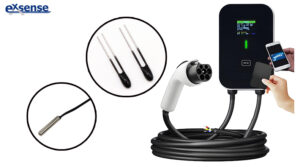From Reactive Protection to Proactive Alert: NTC Temperature Sensors for Charging Piles
 As core infrastructure for charging new energy vehicles, home charging piles bear the critical mission of delivering a safe and efficient power supply to electric vehicles. Their built-in intelligent charging management modules ensure stable operation of basic power functions and establish a comprehensive thermal protection system. This system’s NTC temperature sensors are precisely deployed at key heat-generating points such as power modules and charging gun heads, acting as 24/7 “temperature sentinels.” They monitor component temperature changes in real-time, immediately triggering alert mechanisms upon detecting abnormal heat to fortify operational safety.
As core infrastructure for charging new energy vehicles, home charging piles bear the critical mission of delivering a safe and efficient power supply to electric vehicles. Their built-in intelligent charging management modules ensure stable operation of basic power functions and establish a comprehensive thermal protection system. This system’s NTC temperature sensors are precisely deployed at key heat-generating points such as power modules and charging gun heads, acting as 24/7 “temperature sentinels.” They monitor component temperature changes in real-time, immediately triggering alert mechanisms upon detecting abnormal heat to fortify operational safety.
Given their enclosed chamber design, charging piles accumulate substantial heat from internal electrical components during continuous operation. This heat buildup within the confined space causes internal temperatures to rise significantly above ambient levels. Inadequate temperature management accelerates equipment ageing, increases wear, and may even lead to severe safety incidents like short circuits or fires. Thus, precise temperature monitoring via NTC temperature sensors has become indispensable for safely operating home charging piles.
Ⅰ. Achieving Proactive Alerts and Thermal Safety Upgrades
At critical heat points like power modules and charging interfaces, NTC temperature sensors are sophisticated “electronic nerve endings,” capturing real-time temperature data. The sensors transmit temperature signals to the charging pile’s control chip or microcontroller, which compares readings against preset over-temperature thresholds. If thresholds are exceeded, the control chip immediately activates over-temperature protection—cutting off the charging circuit to halt the process—preventing further temperature escalation and avoiding equipment damage or safety hazards.
During high-frequency, high-current charging sessions, internal modules continuously release substantial heat. Without timely dissipation, this compromises equipment lifespan and operational safety. The industry thus adopts hybrid cooling solutions combining air and liquid cooling:
- Air Cooling:When NTC sensors detect temperatures exceeding 40°C (normal range: 0°C to 40°C), the drive mechanism opens ventilation ports via rotating baffles. External airflow is then driven inward by fans to cool the chamber rapidly.
- Liquid Cooling:Some manufacturers use liquid cooling, circulating coolant through sealed pipes to core heat zones. This method achieves >30% higher efficiency than air cooling, making it ideal for high-power DC charging piles.
Ⅱ.Selecting NTC Temperature Sensors for Charging Piles
Precise sensor selection is vital for charging pile safety and performance. Key considerations include structural design, response speed, and environmental adaptability, with tailored solutions for specific applications:
- Charging Gun Plug Temperature Monitoring
- During high-current fast charging, plug-socket contact points generate intense heat. Uncontrolled temperatures increase contact resistance, reduce efficiency, and risk connection failures or contact melting. NTC sensors must thus be embedded at key contact points within the plug for real-time junction monitoring.
- Selection Criteria:304 stainless steel straight-tube metal encapsulation offers high-temperature/corrosion resistance, enduring frequent plugging cycles and environmental stress. Response time <0.8s ensures rapid reaction to temperature spikes, preventing heat-related failures.
- Power Module Thermal Control
- Power modules transform grid electricity for EV charging as the core power conversion and regulation component. Unmanaged heat from operation reduces conversion efficiency, shortens module life, and jeopardises system safety. NTC thermistors must be precisely mounted on module PCBs to monitor core device temperatures.
- Selection Criteria:Epoxy-encapsulated NTC thermistors soldered onto PCBs ensure direct contact with heat sources for efficient signal conduction. High stability and electrical insulation enable reliable operation under heavy loads and strong EMI, safeguarding consistent charging performance.
Conclusion:
Intelligent thermal systems leverage NTC sensor networks to enable comprehensive temperature monitoring within charging piles, transitioning from reactive to proactive safety protocols while enhancing security and energy efficiency. As technology evolves, EXSENSE’ NTC temperature sensors will play an increasingly expansive role in this domain.













